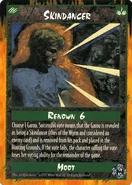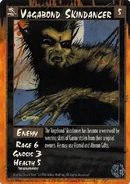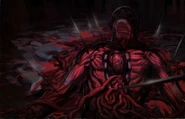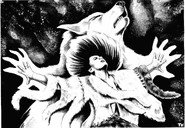The Skin Dancers are a small tribe that is hated and reviled by the Garou Nation and the Black Spiral Dancers alike - but also feared. They are the legacy of the infamous Samuel Haight, for the Skin Dancers were Kinfolk that used the forbidden Ritual of Sacred Rebirth to become full Garou.
Overview[]
If rumours are to be believed, the Skin Dancers have made allegiances with spirits all their own and have started learning new Gifts never before seen by the Garou. They even gained the support of a Totem, Minotaur. Worse still, not all of the Skin Dancers are ex-Kinfolk. In fact, the vast majority of them are Garou who have joined from other tribes, finding a home and understanding they could not find among their own tribes.
The Skin Dancers generally revile all other Garou, including the Black Spiral Dancers, who tried many times to make an alliance with them. Samuel Haight wanted to use them as means to bring down the Garou Nation in his quest for power. But while the Skin-Dancers began in corruption, the vast majority turn away from their former ways, heading toward an inner peace brought on by their First Change.
For many Garou, the First Change is a traumatic experience, painful and frightening. For the Garou created by Haight, the experience was more appropriately termed an epiphany. It’s hard to want revenge against the people that have what you want when you suddenly get what you’ve been after. The bitterness and resentment is not as strong as the Wyrm had hoped, and the Change brings forth an understanding of why the Garou considered their former Kinfolk second-class citizens. Many among the Skin Dancers believe that Gaia retaliated against the Wyrm-spawn Samuel Haight by calming the overwhelming rage of his progeny, thus allowing them a chance at redemption despite their foul origins.
The four original progeny of Samuel Haight are divided. One follows the Laws of Haight, continuing the quest their creator gave them all. One follows the Litany of the Garou, reinterpreting the antiquated rules to better suit the modern world. One follows a New Litany created to join all tribes together and bring forth the final destruction of the Wyrm. The last follows no Litany, simply waiting and learning the truths of the Triat.
The four factions get along fairly well, but have heavy tensions between them. Although there are some conflicts, the extremely low number of Skin Dancers and their mutual enemies means that most conflicts end after a few rounds in a boxing ring or a few days in solitary confinement.
Still, they are hated by the tribes because of the way in which they become Garou — the Ritual of Sacred Rebirth requires the pelts of five Garou to create only one. The second mark against the tribe is also related to their becoming. The ritual’s very nature is of the Wyrm, and all Skin Dancers who experience the legacy of Haight begin their new lives tainted by the Corrupter’s influence, unless all five pelts taken were given freely.
Individual Skin Dancers[]
Gallery[]
Trivia[]
- As of 5th Edition, they have been renamed to Stolen Moons, to avoid connotations to the Navajo Skin-walker.
- Considering that Robert Allred and Haight came up with the name themselves, Skin Dancers was probably mostly used by followers of Haight anyways. Others could have used something else or just be disguised as another tribe.
- However, there are a lot of European myths and folktales that involve the use of a wolf skin, "wolf belt" or "wolf-strap" in order to become a werewolf. Some of the most famous being Sigmund and Sinfjotli. Considering that early White Wolf writers were using Lifetime Books The Enchanted World series and probably even 'Man, Myth and Magic Enclycodias' for reference, they might have been pulling from the black magic ceremony from Elliott O’Donnell's Werwolves (1912). Precisely, Chapter IV: How to Become a Werewolf.
- The Skin Dancers' Totem is Minotaur, also known as the last Apis, "Asterion." However, no connection was ever made between the two in either Second Edition or Revised, considering the role and knowledge the Apis had. W20's Shattered Dreams instead makes the connection to a Balam Kinfolk being responsible for the ritual, despite early lore referencing that Haight discovered the ritual from a cult in India.
- Hunter: The Reckoning's The Moonstruck has two fiction chapters dedicated to an encounter with a Skin Dancer, which even references Enlightened Society of the Weeping Moon texts.
- There is an unnamed female Skin Dancer who shows up in numerous books, starting with the Outcasts: A Players Guide to Pariahs.
References[]
- WTA: Rage Across the Amazon, p. 96 (Robert Allred and Samuel Haight come up with the term, "Skin-Dancers.")
- WTA: The Chaos Factor, p. 127
- WOD: Outcasts: A Players Guide to Pariahs, p. 56-59, 61-63
- WTA: Kinfolk: Unsung Heroes, p. 34-36
- WTA: Players Guide to Garou, p. 210-213
- HTR: The Moonstruck, p. 39-49, 73-83
- W20: Werewolf: The Apocalypse 20th Anniversary Edition, p. 512-514
- W20: Shattered Dreams, p. 111
- W20: Skinner
| Werewolf: The Apocalypse Tribes | |
|---|---|
| Garou Nation | Black Furies · Bone Gnawers · Children of Gaia · Galestalkers (Wendigo) · Ghost Council (Uktena) · Glass Walkers · Hart Wardens (Fianna) · Red Talons · Shadow Lords · Silent Striders · Silver Fangs |
| Beast Courts | Hakken · Stargazers |
| Independent | Boli Zouhisze · Cult of Fenris (Get of Fenris) · Siberakh · Singing Dogs · Stolen Moons (Skin Dancers) · Ronin |
| Fallen | Black Spiral Dancers (White Howlers) |
| Extinct | Bunyip · Croatan |




